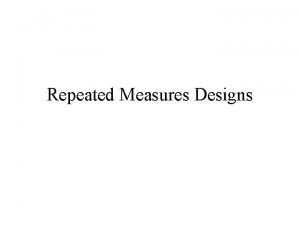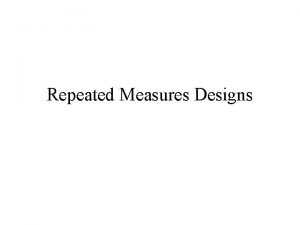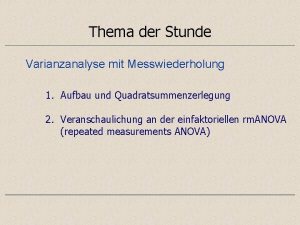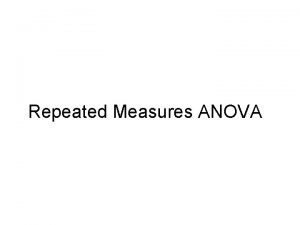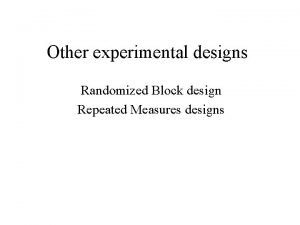Repeated Measures Designs Repeated Measures Type of design























- Slides: 23

Repeated Measures Designs

Repeated Measures • Type of design in which the same participants are used in every group and so are exposed to every level of the IV. • Participants must be measured on the DV multiple times. • Ensures that the groups are identical; so eliminates many E. V.

Quick Class Experiment • Imagine that you are being asked to rate scary media images for a study on children. Rate the pictures using the following scale • 1 = Not scary • 2 = A little Scary • 3 = Moderately Scary • 4 = Very Scary • 5 = Extremely Scary



Switch Groups



Order Effects • When the position of a treatment (level of IV) in a series determines, in part, the participants’ response. e. g. , you “leave some room” in the first rating because you do not know what is coming next.

Carryover Effect • The effects of one treatment persist or carryover and influence responding to the next treatment. e. g. , the first picture “anchors” your view of the second picture.

Are there possible order or carry-over effects?

What if we want to add another level?

How many sequences will we need? Do we have enough people to adequately cover each sequence?

Differential Carryover Effect • Response to a treatment depends on which specific treatment came before it. – An unforeseen and unavoidable problem! – Which alien sequence might produce this effect?

Counterbalancing Dependent Variables • Order effects aren’t just for IVs. • How you order questions in your survey can also show these effects. • As participants get bored or tired, order effects can show up in some questions. • Counterbalancing questions can even this out within your groups.

Question Order Discussion • Imagine your group wants to collect opinions on _______. • Write 3 questions that if ordered differently might produce order effects?

Types of Counterbalancing

Within Subjects Counterbalancing • Every participant gets all possible sequences. – ABBA design • Reasonable if you only have 2 levels. Coke Pepsi Coke But then they are responding multiple times to the same stimulus so other problems arise.

Within Groups Counterbalancing • Different participants get different sequences but each sequence is given to the same number of participants. • More common.

Complete Counterbalancing • All possible sequences are presented

Incomplete Counterbalancing • Random selection of sequences chosen.

Why bother with repeated measures? Eliminates a lot of extraneous variables related to participants? How many alien movies have you seen? Do you have phobias about aliens?

Moral of the Story! • Beware of repeated measures, particularly if you have more than 2 levels of the IV.
 Repeated-measures design
Repeated-measures design Repeated-measures design
Repeated-measures design Repeated measures design psychology
Repeated measures design psychology Matched groups design
Matched groups design Unit 2 ap psychology
Unit 2 ap psychology Between subjects design vs within
Between subjects design vs within Repeated measures design psychology
Repeated measures design psychology Repeated measures design
Repeated measures design Repeated measures design
Repeated measures design Andy field repeated measures anova
Andy field repeated measures anova Mixed design anova spss
Mixed design anova spss Manova with repeated measures
Manova with repeated measures Repeated measures anova deutsch
Repeated measures anova deutsch Spss viewer
Spss viewer March
March Cscar
Cscar Two-way repeated measure anova
Two-way repeated measure anova Mixed model repeated measures
Mixed model repeated measures Repeated measures anova jmp
Repeated measures anova jmp Type checking and type conversion in compiler design
Type checking and type conversion in compiler design Abstraction-occurrence design pattern
Abstraction-occurrence design pattern The recurring aspects of designs are called design
The recurring aspects of designs are called design The recurring aspects of designs are called design
The recurring aspects of designs are called design Repeated acquisition design
Repeated acquisition design

